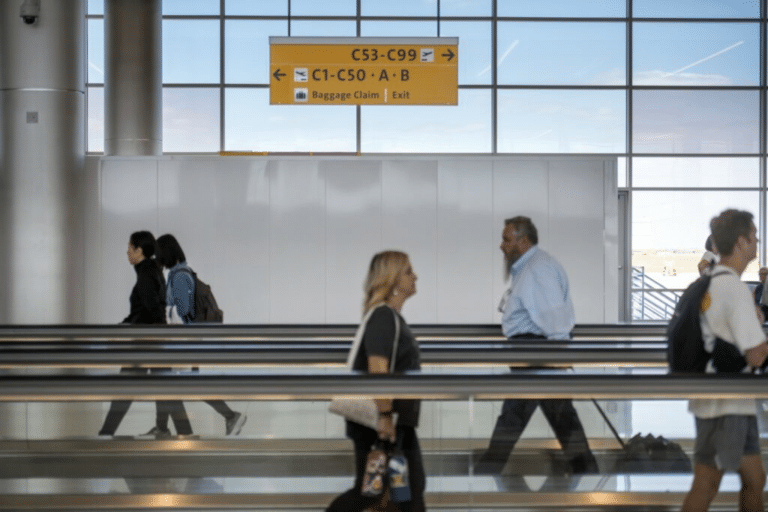Performing construction at active airports comes with added challenges, but safety is the real concern. Let’s explore the best practices for safe zone construction at airports to maximize safety while keeping travelers and commercial activities moving.
Maintaining the Excellent Safety Record of the Airline Industry when Undergoing Construction Near Aircraft
While air traffic controllers perform their admirable duties of taking care of aircraft from gate to sky, it’s the duty of the airport facilities to ensure travelers are not bothered in any way. Due to this, any construction on the interior of the airport must follow significant guidelines to make sure operations run smoothly and safely.
In fact, the safety in construction zones becomes a priority for maintaining the integrity of airport operation, especially when the airport is expanding.
How to Make a Construction Site Safe: Best Practices for Safe Zone Construction in Airports
To keep travelers and personnel safe during construction inside the airport, there are 4 main concerns:
Dust Control
Construction creates dust. The sawing, hammering, and drilling from workers—including the constant movement of construction teams—causes dust to spread around environments, which can affect travelers nearby.
To remedy this, construction crews often erect temporary walls that keep dust within the construction zone, so it does not cross into the passenger and retail areas.
Separation
Airports are already a busy environment—full of moving individuals—and there’s no reason to put travelers in harm’s way to construction teams. Likewise, construction personnel need a “safe space” from where they can get the job done. Temporary walls are able to separate construction sites from passengers and commercial activities within airports, helping ensure that no one can be physically harmed by construction activities.
Sound Control
Similar to the above, controlling the loud noises of construction is a priority for safety. Many tools and other equipment are loud while operating, which can not only be disruptive to retail businesses and passenger communication at best and dangerous at worst. Temporary walls can help by reducing the transmission of sound from the work zone.
Logistical Flow of Passengers
Airports can’t always choose the ideal areas of their facility to expand without impacting travelers. The best way to handle this is to make sure travelers can safely get to where they need to go without creating crowding or confusion. Therefore, creating a logical and easy to understand movement throughout the airports, with lots of signage, helps travelers find there way. Again, temporary walls can be used as a physical barrier that assist passengers to where they need to be. In fact, airport teams can even add images and signs to temporary walls.
Modern Temporary Walls for Safe Zone Construction at Airports
Traditionally, temporary walls are built from stud and drywall to separate the work zone from non-work zones and keep dust at bay.
The issue with stud and drywall, however, is that they have to be constructed (creating additional dust), cannot be moved once built, and have to be torn down and discarded. While they do block dust and provide separation, the work involved with traditional stud and drywall temporary systems can be a bit of a headache, not to mention, wasteful, which could be avoided.
Modular temporary wall systems can remedy this. Although they are lighter and easier to install, they are even more durable and can be rearranged during the construction phases.
Essentially, they eliminate all of the issues and downsides of stud and drywall temporary walls while adding many impressive features.
Let’s explore two wall systems that airports across North America are relying on to provide safety during renovation and construction.
Swiftwall® Temporary Wall Systems for Safe Zone Construction Sites
Swiftwall® is an industry leader in the modular temporary wall space. Already used at some of the nation’s largest and most important airports, Swiftwall® temporary wall systems are the perfect solution to keep dust at bay, provide excellent separation between passengers and the work zone, while also being easy to install and reusable.
In fact, Swiftwall® wall systems install 5x faster than traditional stud and drywall walls and can be used 15+ times. Here are the two go-to temporary wall systems for safe zone construction at airports:
Swiftwall® Pro

Swiftwall®’s flagship product, Swiftwall®® Pro is a powerful temporary wall system in use by airports to keep construction and its dust at bay. Panels made of non-hygroscopic ABS are joined by aluminum joiners and fit in a simple track and panel system, allowing installation to be 5x faster than traditional stud and drywall temporary walls and can even be performed by a single individual. Multiple standard panel heights are available and can be stacked to any height: 4, 8, 10, 12 and 16 ft (by 4 ft wide). The panels are quickly reconfigured and offer a STC21 sound rating and Class C flame spread rating with optional Class A aluminum skins.
Swiftwall® Max

The most durable temporary wall system available, Swiftwall®® Max is the perfect choice for load-bearing application, including those involving wind and seismic activity. It is excellent for high-traffic areas as it is able to withstand everyday wear and tear. Standard panel heights for Swiftwall® Max are 8 and 10 ft by 2 ft wide. The panels are made of non-porous, non-combustible, weather resistant marine aluminum panels with a white powder-coated smooth, glossy, mold and mildew resistant, easy to clean finish. Although Swiftwall®’s most durable and powerful temporary wall systems, Swiftwall® Max still can be installed 3x faster than traditional temporary walls.
Achieve Safe Zone Construction Best Practices at Airports with Swiftwall® Temporary Wall Systems
Creating isolated safe zone construction sites at airports is critical, and Swiftwall® temporary wall systems are the perfect complement to airport construction activity, which is why they are already being used at some of the nation’s largest airports.
To learn more about how Swiftwall® temporary wall systems can help keep your airport safe and running during construction and renovation, reach out to our experts today.


